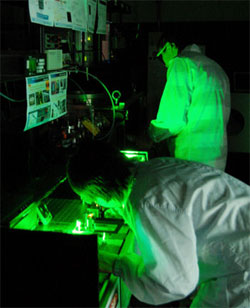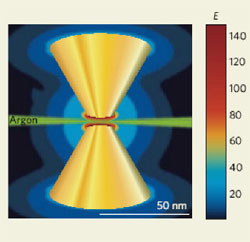According to KAIST reseachers in Korea, a bow tie-shaped gold nanostructure on a saphire substrate can enhance the intensity of femtosecond laser light pulses by two orders of magnitude.
The devise is smaller and cheaper than existing systems and might allow a laptop-sized extreme ultraviolet (EUV) source to be used in high-resolution biological imaging, advanced lithography of nanoscale patterns and perhaps even X-ray clocks, which are being investigated worldwide to replace the current caesium atomic clocks for better time precision.

EUV light in the lab. Photo courtesy of Seung-Woo Kim.
Current methods rely on using amplified light pulses from an oscillator to ionize noble gas atoms, making it difficult to produce EUV radiation. The electrons freed during this process are accelerated in the light field and their surplus energy is freed as attosecond pulses of light of different wavelengths. The shortest wavelength of light can then be filtered out to produce a single EUV pulse.
Scientists would ideally like to produce EUV light directly from the oscillator without the need for expensive and bulky amplifiers. In this way, EUV generation could be simplified and the size of the source significantly reduced to tabletop dimensions.
Current devises usually measure around 2-3m across,while the bowtie-shaped gold nanostructure measures 20nm across, which enhances the intensity of femtosecond laser light pulses.

The bow-tie-shaped gold nanoantennas develop electric-field strengths in the gap through interactions with quasiparticles known as surface plasmons. (The field strength E is colour-coded) When a beam of argon atoms (green) is directed towards the gap, the field strips them of electrons, which subsequently recombine - a process that results in the generation of high harmonics of the original light, including the sought-after extreme ultraviolet radiation. (Data and calculations courtesy of J. Aizpurua; image and text courtesy: Nature)
According to Seung-Woo Kim and fellow researchers of KAIST in Daejeon, this technique works thanks to resonant plasmon field enhancement, which is sensitive enough to detect individual molecules on a metal surface. When surface plasmons in the gap of the bow tie gold nanostructurees are illuminated with the correct frequency of laser light, they resonate in unison, greatly increasing the local light field intensity.
The researchers now plan to improve the conversion efficiency of the generated light by modifying the design of their nanostructure – for example, by making 3D cones with sharper tips. These will not only enable higher local field enhancement, but also better interaction of the femtosecond light pulses with injected gas atoms. The team will also test the spatial and temporal coherence of the generated EUV light.
To find out more about KAIST, visit:
www.kaist.edu